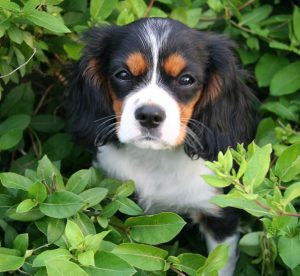Grooming your Cavalier King Charles Spaniel isn’t difficult. A little care on a regular basis will keep your dog’s coat silky and shiny.
Regardless of the color of your Cavalier’s coat, these simple grooming principles will guide you through the process.
Grooming Tools
Find our handy checklist of grooming tools and pet supplies here.
For young Cavalier King Charles Spaniel puppies, the best brush to use is a soft bristle brush which is likely to be the only grooming tool you’ll need for your pet’s first year. A grooming glove makes a good alternative as it will provide a light massaging action while you groom your puppy’s coat.
As your Cavalier King Charles Spaniel’s coat lengthens, expand your collection of grooming tools to include a metal comb (ideally with two different size teeth) to help with snarls and tangles, a pin or slicker brush for your dog’s body, and eventually a de-shedding tool.

With each new tool, give your pet a chance to see and smell the item, and begin using it in short sessions until your Cavalier King Charles Spaniel understands there is nothing to fear.
Grooming Cavalier Puppies
Cavalier King Charles Spaniel puppies need very little grooming for six months to a year as they grow into their long, luxurious coat. Spend time with your Cavalier puppy now to gently prepare him to enjoy grooming sessions as an adult dog.
Introduce grooming gently and in short sessions. While holding your puppy, begin by moving your hands over his body with a light touch.
You may wish to use a grooming glove to give your Cavalier baby a light massage.
Gently use your fingers to massage each of your puppy’s toes. This will pave the way for clipping your dog’s nails later. Fondle his ears a bit so that he eventually becomes accustomed to having his ears cleaned.
Safety comes first
It’s important to find a safe place for grooming your Cavalier King Charles Spaniel. This depends largely on your dog’s age and how familiar he is with your grooming ritual.
Puppies, in particular, may squirm around or make a sudden jump while being groomed.
If you decide to lift your dog to your standing height (e.g., to a tabletop or kitchen countertop), secure your Cavalier with a tether to protect against possible injury should they pull away or try to jump down.
Though it’s perhaps less comfortable for the owner, it may be safer to sit on the floor to groom your Cavalier.
Adult Dog Grooming Guide

- Make sure your Cavalier King Charles Spaniel is completely dry before grooming your dog. Wet or sticky knots of fur are especially difficult to work through.
- Begin with a pin or slicker brush, making short strokes at the very tips of your Cavalier’s fur. As long as you don’t feel any resistance from tangled fur, then take progressively longer sweeps with the brush. Once you’re confident the brush moves easily through your Cavalier’s coat, you can use a comb for the final finishing strokes.
- Start with your dog in the “sit” position, brushing out the fur on the chest and then down his back. Next, lay your Cavalier down on his side to brush his stomach, under his legs, and the long feathers on the back of his legs. Hold the long plume of tail feathers out of the way until you’ve brushed or combed out the fur along his hind quarters.
- Leave the famously long and lustrous ears of your Cavalier King Charles Spaniel till last. They will generally require an extra gentle touch. Turn the ear over to your dog’s shoulder and begin by brushing the ends of the inside of the ear and gradually moving closer to your pet’s head. Turn the ear over and follow the same approach for the outside of the ear. This is also a perfect time to clean your Cavalier’s ears.
- If your Cavalier King Charles Spaniel’s undercoat needs thinning, run a deshedding brush over your pet at the end of your grooming session.
Handling Snarled and Matted Fur

The hardest part of grooming your Cavalier King Charles will be dealing with snarled or matted fur. It’s not unusual for their fur to become tangled under their ears, in the feathering of their chests, or under the tail.
Regular grooming is the best prevention against these difficulties as brushing removes dirt from your pet’s coat and distributes their skin’s natural oils throughout their coat.
When you do encounter a snarl or matted fur, set the brush aside and begin by trying to ease the knotted hair apart with your fingers. If you find it necessary to use your metal comb, begin with the widest teeth and hold the comb as you would a knife.
Slowly, pull a few strands of hair out of the knot a little at a time until you can free the tangle.
If you find mats under your Cavalier’s ears, in particular, this is a good time to clean your pet’s ears. Ear wax and dirt make snarls more likely to occur.

Wet a cotton ball with a safe, non-alcohol-based ear cleaner to remove dirt from your pet’s ear canal. (I always used Virbac EPIOTIC Ear Cleanser to clean Bentley’s ears.) You may also use the ear cleaner for the fur around the ear.
Is it Okay to Shave a Cavalier King Charles Spaniel?
Many pet owners (myself included) believe a Cavalier King Charles Spaniel’s coat should never be cut or shaved (beyond permissible clipping of the fur between the foot pads), even in warmer weather.
Read our post about shedding to understand why shaving a double-coated dog, like Cavaliers, runs a greater risk of heat stroke.
Other Articles
How to give your Cavalier King Charles Spaniel a Bath at Home


